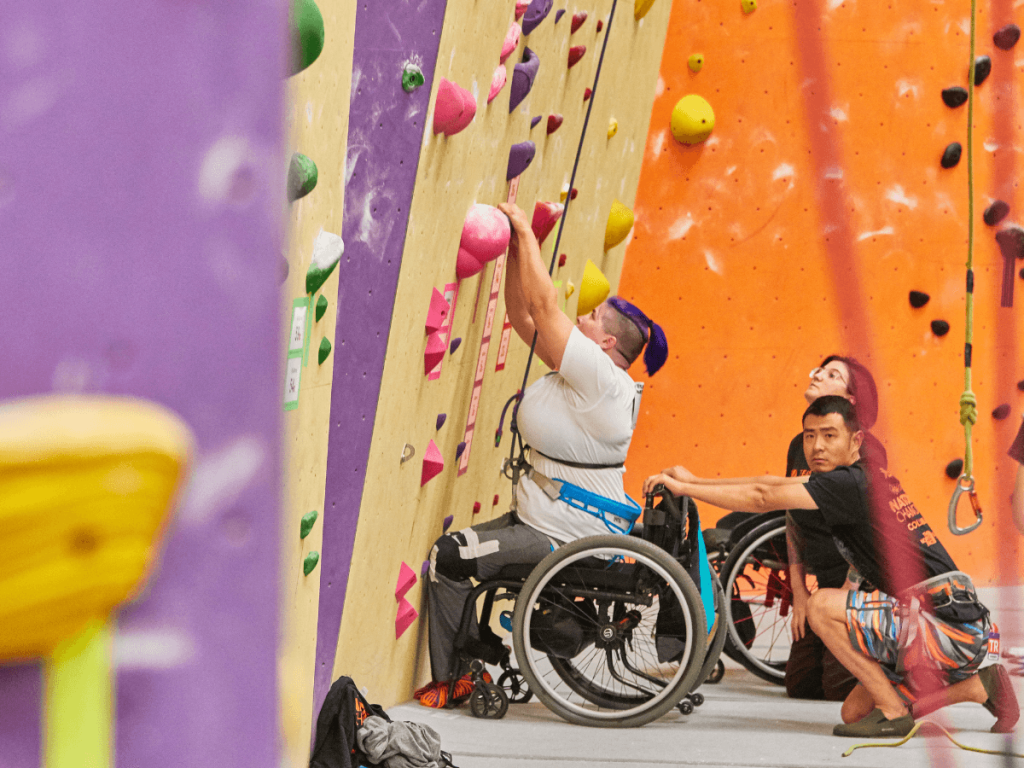Adaptive climbing is not just about overcoming physical challenges; it’s about breaking down barriers and fostering inclusivity within the climbing community. By providing opportunities for individuals with disabilities to participate in the sport, adaptive climbing promotes diversity, empowerment, and a sense of belonging.
What is Adaptive Climbing?
Adaptive climbing, or paraclimbing, is the classification of climbing that aims to make the sport accessible to people of all abilities, including those with physical disabilities or cognitive impairments.
Adaptive climbing allows those who may not have the same opportunity as many climbers to enjoy the sport and push their limits. It gives others a way to find a connection between their mind and body while healthily challenging themselves.

History of Adaptive Climbing
Adaptive climbing gained traction in 1989 after Mark Wellman became the first adaptive athlete to climb El Capitan (El Cap), a 3,000-foot-tall rock face in Yosemite National Park. Seven years before this first ascent, Wellman broke his back and lost most of the use of his legs after a 100-foot fall.
Like in many sports, adaptive athletes have been enjoying and competing for years. Although climbing was slower to gain traction with adaptive athletes, it is recognized worldwide. The first international paraclimbing competition was held in France in 2003, and the first World Championship happened in Italy in 2011. The International Federation of Sport Climbing (IFSC) hosts paraclimbing competitions in the same disciplines as its non-adaptive athletes- lead, boulder, and speed climbing. Adaptive climbers are put into categories of similar adaptive athletes to keep the competition fair.
Adaptive Climbing Athletes
Other adaptive climbers host a range of disabilities, from blindness to amputated limbs. These athletes haven’t let anything stop them from pursuing their dreams. To name a few:
Wayne Willoughby contracted paralytic polio at just nine months old in 1953. However, Willoughby didn’t let this disease stop him. He has gone on to complete a long list of first adaptive ascents. Most notably, in an effort that took over 17 hours, he became the first adaptive climber to send El Cap in a single day!
Mo Beck is a one-handed climber from New England. She went on to win numerous Paraclimbing World Championships and now resides in the Colorado Front Range where she works with organizations like the AAC and USAC to improve the world of paraclimbing.
Sean O’Neill was paralyzed from the waist down in an accident at the age of 19. He climbs big wall with his brother, Timmy, and became the first paraplegic climber to lead climb a route!
Quinn Brett survived a 140-foot while climbing The Nose on El Capitan in 2017 that resulted in her being paralyzed from the waist down. Before the fall, Brett completed many challenging climbs and first ascents worldwide. The accident hasn’t stopped her love for climbing, even if it looks slightly different now.
These feats show that no matter your disability, you can achieve extraordinary things!
Adaptive Climbing Partners
Paradox Sports, founded in part by Sean’s brother Timmy O’Neill and with the help of The North Face, runs training programs that help gyms set inclusive climbing routes.
Adaptive Adventures hosts community-based climbing events and helps introduce adaptive athletes to climbing gyms nationwide. They also run trips to get adaptive athletes climbing outside!
Misty Mountain Threadworks designs and creates harnesses for adaptive athletes to climb safely with minimal risk of skin damage like a typical harness.
The Importance of Adaptive Climbing
Adaptive climbing is important because it allows those who have become paralyzed in a fall, lost a limb, or are blind to enjoy rock climbing. Like Wayne Willoughby, not all adaptive climbers were climbers before their injuries. This showcases how powerful climbing can be not just for the body but also the heart and soul.
Adaptive climbing proves how inclusive rock climbing is. There is no discrimination when it’s you vs. a route. The only real obstacle you’re facing is yourself, making rock climbing the best activity for challenging your mind and body.
Adaptive climbing isn’t just about reaching the summit; it’s about the journey of self-discovery, empowerment, and camaraderie. Embracing adaptive climbing can enrich the climbing community, push the boundaries of what’s possible, and ensure that climbing truly becomes a sport for everyone.

Recent Comments